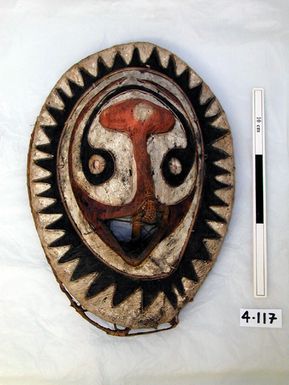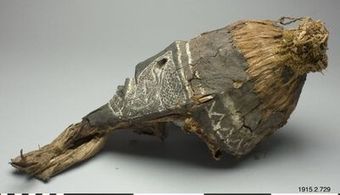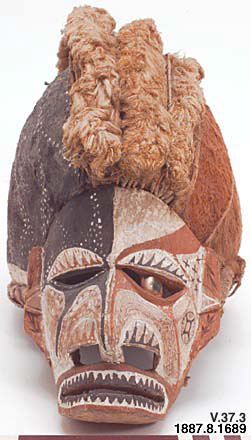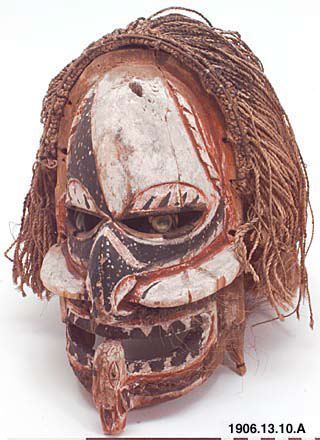Connect with Horniman Museum and Gardens
Contact this content partner to get more information about this item.
mask
- Description:
- Clowning Dance Mask, Eharo, Elema People, Papuan Gulf, Papua New Guinea. The Hevehe ceremony was a central part of traditional Elema life, and could take up to twenty years to run its full course. The serious business of Hevehe focused on bringing powerful Ma Hevehe spirits into the village from the sea where they lived; these spirits took the form of enormous and terrifying masks up to 7m tall which appeared out of the men’s initiation house (eravo) at the ceremony’s climax. Lightening the tone of the ceremony in its early stages, months or years before the appearance of the Ma Hevehe, were the Eharo masks. Frequently representing ridiculous members of Elema society (balding men, the lecherous and uninitiated boys) the Eharo masks were worn by clowns who danced at the completion of a high, narrow doorway on the façade of the eravo house, which enabled the Ma Hevehe masks to leave the house one they were completed. Made from painted barkcloth stretched over a framework of split bamboo, Eharo were light to wear, but obscured the user’s vision almost entirely. Such masks were brought to the eravo house of the village hosting that particular Hevehe ceremony from the many surrounding villages who participated in it, and the masks were kept in the house until the completion of the ritual. Then they were all burnt or simply thrown away. Wood, barkcloth, pigment. Late 19th Century. Formerly in the private collection of Mr W.D. Webster. Dance mask associated with the 'ma hevehe' ritual cycle. While traditional hevehe masks are large and restricted to be manufactured only by those men who have purchased the right, this eharo mask is a comical figure that introduces feelings of happiness and humour into the ritual cycle.
- Format:
- image
- Collections:
- Horniman Museum and Gardens
- Content partner:
- Horniman Museum and Gardens
- Availability:
- Not specified
-
Copyright status: All rights reservedFind out more about what you are able to do with this itemThis item is all rights reserved, with means you'll have to get permission from Horniman Museum and Gardens before using it. For more information, please see our use and reuse page.More informationHorniman Museum and Gardens has this to say about the rights status of this item:
http://rightsstatements.org/vocab/InC/1.0/
What can I do with this item?Non-infringing useNZ copyright law does not prevent every use of a copyright work, and this item may be hosted by an international institute or organisation. You should consider what you can and cannot do with a copyright work.No sharingYou may not copy and/or share this item with others without further permission. This includes posting it on your blog, using it in a presentation, or any other public use.No modifyingYou are not allowed to adapt or remix this item into any other works.No commercial useYou may not use this item commercially.
Welcome and warm Pasifik greetings
The information on this site has been gathered from our content partners.
The names, terms, and labels that we present on the site may contain images or voices of deceased persons and may also reflect the bias, norms, and perspective of the period of time in which they were created. We accept that these may not be appropriate today.
If you have any concerns or questions about an item, please contact us.



